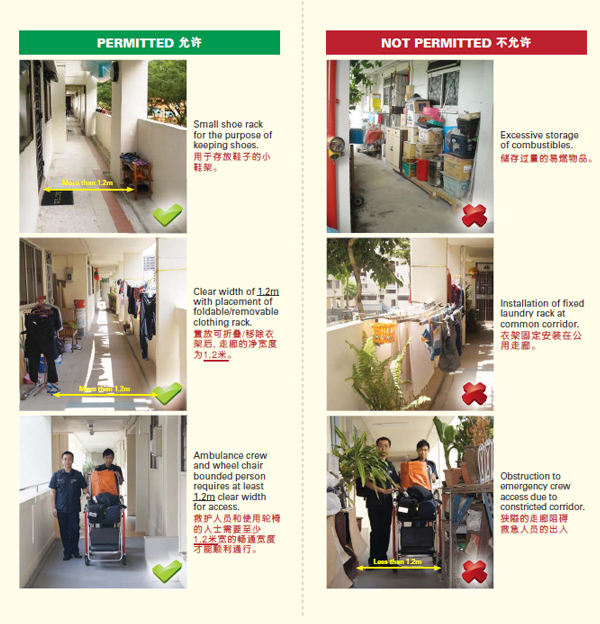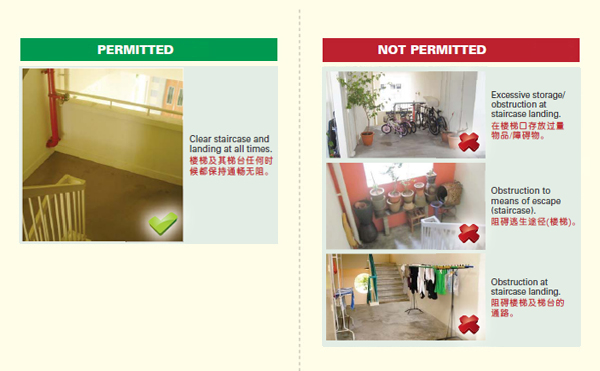REMINDER: COMPLIANCE WITH BUILDING LAYOUT RELATED REQUIREMENTS IN SS 550:2020
Objective
This circular reminds developers, qualified persons (for building plan), specialist professional engineers (for lifts and escalators) and lift installation contractors on building layout related requirements specified in SS 550:2020 - Code of Practice for Installation, Operation and Maintenance of Electric Passenger and Goods Lifts.
Background
2. For the performance of regular maintenance, inspection, repair or emergency rescue works, lift service personnel would need to access lift machine rooms/machinery spaces.
However, there have been circumstances in which the accessway provided for lift service personnel were too narrow and/or obstructed (e.g. by pipes, services or equipment), or were unsheltered (inadequate protection against rain and lightning). These conditions can hinder the service personnel’s (who may be carrying bulky equipment) performance of their works, especially during emergency situations.
Compliance with requirements on building layout related requirements in SS 550:2020
3. In January 2021, BCA issued a circular to inform that, with effect from 1 July 2021, any lift proposed in a project whose first set of plans is submitted to the Commissioner of Building Control for approval under the Building Control Act on or after this date would be required to comply with SS 550:2020. Please refer to the circular at https://www1.bca.gov.sg/docs/defaultsource/docs-corp-news-and-publications/circulars/circular-on-adoption-of-ss-550-2020.pdf.
4. Besides the design and installation of lifts, the SS 550 also covers requirements which are related to the building layout in areas of the lift shafts, machine rooms and roof access (if the machine room is located there). In particular, we would like to highlight the following requirements relating to access to the lift machine room. See Annex A for the list of building layout-related requirements in SS 550.
- Sheltered passageways providing access to machine rooms/machinery spaces shall be of clear width of at least 1m and clear height of at least 2m;
- Safety railings shall be provided along the passageways if the passageways are less than 1.5m away from the edge of the roof/building; and
- Access between a machine room/machinery space and the floor below should be by staircase. When a staircase cannot be provided, a ladder can be used where the height between a machine room/machinery space and the floor below is not more than 4m. For use of a ladder that is more than 3m in height, fall protection shall be provided.
5. Such requirements should be considered and provided for upfront in the building plan to avoid unnecessary abortive works and delays downstream when the building is almost completed.
6. During our recent audit of building plans of the projects which were subject to paragraph 3 above, it was found that some of these projects had not complied with the requirements in SS 550. Consequentially, there were unnecessary delays to the approval for the applications for Permit-to-Operate for the lifts as the qualified persons sought to regularise the noncompliances.
7. The Building and Construction Authority (“BCA”) would thus like to remind the industry to take note of the building layout related requirements in SS 550 and ensure that their projects comply with these requirements upfront. Please do not to leave the issues to be addressed at the installation stage of the lifts.
Feedback and Clarification
8. For further information, feedback or clarification, please submit your enquiry through BCA’s Online Feedback Form at https://www.bca.gov.sg/feedbackform or call us at (65)1800-342 5222 (1800-DIAL BCA).
Annex A
Clause 5.2.2 of SS 550:2020- Access to well and to machinery spaces and pulley rooms
5.2.2.1 The well, machinery spaces and pulley rooms and the associated working areas shall be accessible. Provisions shall be made to allow access to spaces other than the car interior only to authorised persons.
See also Annex D.
5.2.2.2 The access way adjacent to any door/trap giving access to the well or to machinery spaces and pulley rooms shall be lit by a permanently installed electric lighting with an intensity of at least 50 lux.
5.2.2.3 If access to the lift for maintenance and rescue purposes is via private premises, then permanent access of authorised persons to the premises and relevant instructions shall be provided.
The building designer/architect/owner shall be aware of the problems of access, fire, entrapment and also of security associated with lifts serving directly into private premises (see 0.4.2 information exchange).
5.2.2.3.1 As a minimum, permanent maintenance access must be provided at the topmost,lowest landings and preferably also at one or more intermediate landings.
5.2.2.4 A means to enter the pit shall be provided consisting of;
a) an access door where the pit depth exceeds 2,50 m;
b) either an access door or a ladder inside the well, easily accessible from the landing door,where the pit depth is not exceeding 2,50 m.
Any pit access door shall comply with the requirements of 5.2.3.
Ladders shall comply with Annex F.
5.2.2.5 A safe access for persons to machinery spaces and pulley rooms shall be provided.
Passageway shall be sheltered with a clear width of 1.0 m and clear height of 2.0 m. Access floor shall be treated such that it is not slippery and safety railings provided along passageway if it is less than 1.5 m from edge of roof/building. For difference in height in the access passageway, this should be effected entirely by way of stairs. In the exceptional case when a conventional staircase cannot be provided, ladders satisfying the following requirements shall be used:
a) the access to the machinery spaces and pulley rooms shall not be situated more than 4 m above the level accessible by stairs; For access over 3 m in height by ladder fall protection shall be provided;
b) ladders shall be fastened to the access permanently or at least by rope or chain in such a way that they cannot be removed;
c) ladders exceeding 1,50 m in height shall, when in position for access, form an angle between 65° and 75° to the horizontal and shall not be liable to slip or turn over;
d) the clear width of the ladder shall be at least 0,35 m, the depth of the steps shall not be less than 25 mm and in the case of vertical ladders the distance between the steps and the wall behind the ladder shall not be less than 0,15 m. The steps shall be designed for a load not less than 1500 N;
e) adjacent to the top end of the ladder there shall be at least one hand hold within easy reach;
f) around a ladder, within a horizontal distance of 1,50 m, the risk of falling by more than the height of the ladder shall be prevented.






